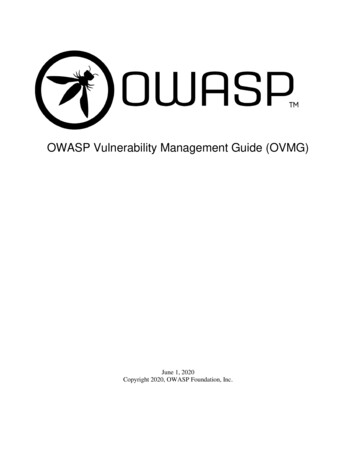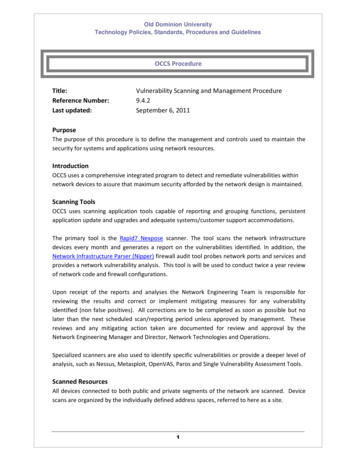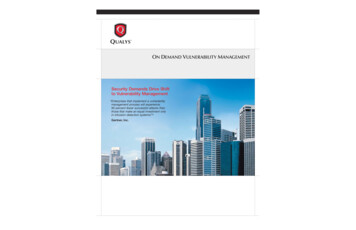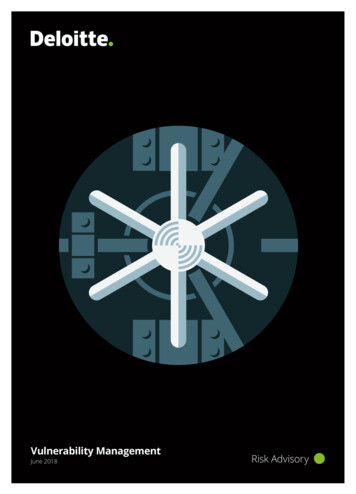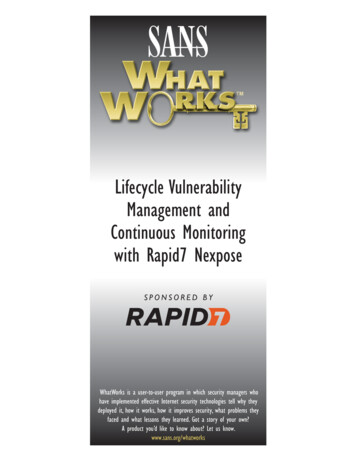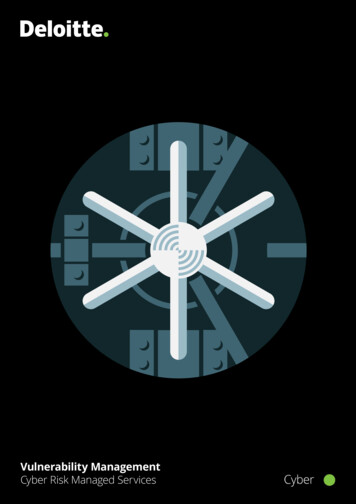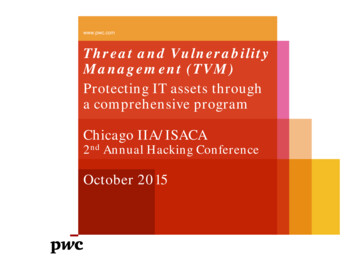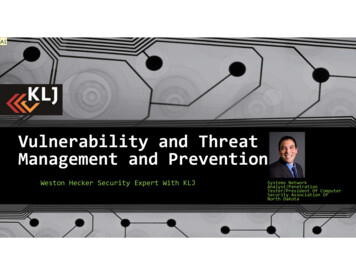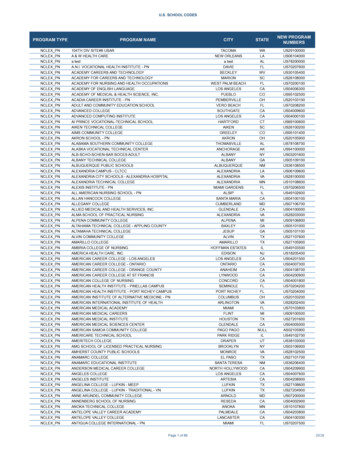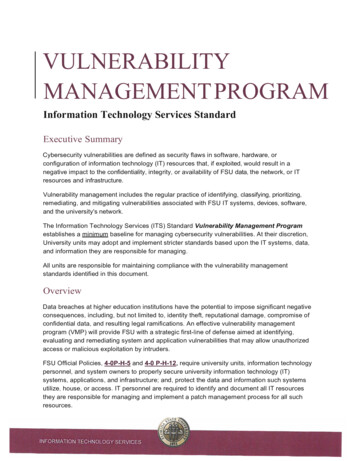
Transcription
VULNERABILITYMANAGEMENT PROGRAMInformation Technology Services StandardExecutive SummaryCybersecurity vulnerabilities are defined as security flaws in software, hardware, orconfiguration of information technology (IT) resources that, if exploited, would result in anegative impact to the confidentiality, integrity, or availability of FSU data, the network, or ITresources and infrastructure.Vulnerability management includes the regular practice of identifying, classifying, prioritizing,remediating, and mitigating vulnerabilities associated with FSU IT systems, devices, software,and the university's network.The Information Technology Services (ITS) Standard Vulnerability Management Programestablishes a minimum baseline for managing cybersecurity vulnerabilities. At their discretion,University units may adopt and implement stricter standards based upon the IT systems, data,and information they are responsible for managing.All units are responsible for maintaining compliance with the vulnerability managementstandards identified in this document.OverviewData breaches at higher education institutions have the potential to impose significant negativeconsequences, including, but not limited to, identity theft, reputational damage, compromise ofconfidential data, and resulting legal ramifications. An effective vulnerability managementprogram (VMP) will provide FSU with a strategic first-line of defense aimed at identifying,evaluating and remediating system and application vulnerabilities that may allow unauthorizedaccess or malicious exploitation by intruders.FSU Official Policies, 4-0P-H-5 and 4-0 P-H-12, require university units, information technologypersonnel, and system owners to properly secure university information technology (IT)systems, applications, and infrastructure; and, protect the data and information such systemsutilize, house, or access. IT personnel are required to identify and document all IT resourcesthey are responsible for managing and implement a patch management process for all suchresources.
All computers and other devices capable of running anti-malware software also must employlicensed and up-to-date anti-malware software that cannot be disabled by end-users. Allcomputers and other devices must have installed up-to-date security patches. Failure to meetthese requirements may result in revocation of network access.Unit ResponsibilitiesVulnerability IdentificationFor devices and applications that support credentialed vulnerability scans, units are required toimplement credentialed scans to ensure that scan results are accurate/complete and reduce thelikelihood that certain vulnerabilities would otherwise be missed or overlooked. Appliances orother devices that are auto updated by the vendor or not under the control of FSU shall also bemonitored by units to ensure security updates are applied in a timely fashion. For questionsrelated to credentialed scans, please contact the ISPO for additional information.All FSU systems and applications are required to be scanned for vulnerabilities, using the ITSvulnerability scanning system, on at least a monthly basis.Units are responsible for ensuring all of their systems are scanned monthly, reviewing theresults of the scan, and determining, what, if any, additional mitigations or remediation activitiesare required to be implemented, based on the vulnerability's risk level described in VulnerabilityClassifications.Identified vulnerabilities shall either be mitigated or remediated in accordance with the timelinedescribed in Mitigation and Remediation Timeline Requirements; or, shall have received documentedand approved exceptions from the Information Security and Privacy Office (ISPO).All units are responsible for developing and implementing patch management processes toapply operating system and/or application security patch updates for the IT systems, devices,and applications they are responsible for managing. Similarly, the system and applicationowners shall adopt and implement baseline, hardened configurations for all systems they areresponsible for operating, managing, or supporting.If units determine that credentialed scans cannot be implemented, or if there is substantial riskassociated with running credentialed vulnerability scans, they are required to request anexemption using the process discussed in Vulnerability Remediation Exemptions.Vulnerability ClassificationITS employs enterprise level patch management and vulnerability scanning tools that may differslightly in terms of classification systems and/or terminology. The following vulnerability riskclassifications describe severity levels that may be assigned to an identified vulnerability with anattempt to consolidate terminology used as it relates to this standard.Sources for cybersecurity vulnerabilities information, CVSS scores, and related risks andexposures include: the National Vulnerability Database, which can be found atITS I Vulnerability Management Program: ITS Standard2
https://nvd.nist.gov/vuln-metrics/cvss; and, the Common Vulnerability Exposure Database,located at https://cve.mitre.orgCritical Risk VulnerabilitiesLoss of system or data [Confidentiality I Integrity I Availability) is likely to have a catastrophicadverse effect on the organization or individuals associated with the organization, e.g., students,faculty, and staff. Exploit development has reached the level of reliable, widely available, easy to-use automated tools. Flaws could be easily exploited by an unauthenticated (orauthenticated) remote attacker and lead to system compromise (arbitrary code execution)without requiring user interaction. Critical CVSS Base Score 9.0-10.0.High Risk VulnerabilitiesLoss of system or data [Confidentiality I Integrity I Availability] is likely to have a catastrophicadverse effect on the organization or individuals associated with the organization (e.g.,employees, customers). Functional exploit code is available. The exploit code works in mostsituations where the vulnerability exists. These types of vulnerabilities allow local users to gainprivileges, allow unauthenticated, remote users to view resources that should otherwise beprotected by authentication, allow authenticated remote users to execute arbitrary code, or allowremote users to cause a denial of service. CVSS Base Score 7.0-8.9.Moderate Risk VulnerabilitiesLoss of system or data [Confidentiality I Integrity I Availability) is likely to have a serious adverseeffect on the organization or individuals associated with the organization (e.g., employees,customers). This rating is given to flaws that may be more difficult to exploit but could still leadto compromise under certain circumstances. These are the types of vulnerabilities that couldhave a critical or important impact but are less easily exploited based on a technical evaluationof the flaw, or affect or require an unlikely configuration. CVSS Base Score 4.0-6.9.Low Risk VulnerabilitiesLoss of system or data [Confidentiality I Integrity I Availability) is likely to have only a very limitedadverse effect on the organization or individuals associated with the organization (e.g.,employees, customers).These are the types of vulnerabilities that are believed to requireunlikely circumstances to be able to be exploited, or where a successful exploit would causeeither no adverse effects, or, result in only very minimal adverse consequences. CVSS BaseScore 0.1-3.9.Patch and Configuration ManagementPatch ManagementVulnerabilities that are directly related to missing security patches shall be remediated within thetimeframes established under Vulnerability Mitigation and Remediation below. Remediation andmitigation activities should be prioritized based on the assigned vulnerability classification, theresulting exposure to the unit or University if the vulnerability was exploited.ITS I Vulnerability Management Program: ITS Standard3
Configuration ManagementFor configuration changes, system owners, and system/application administrators areresponsible for performing effective testing and for following a consistent internal changemanagement process.Security Patch Management RequirementsSystem and application owner(s) and/or administrator(s) shall develop and implement a methodto show vendor and 3rd party security alerts are regularly reviewed against unit configurationstandards and installed and recommended or available patch levels. The output of this processshall be made available to ISPO upon request.Vulnerability Mitigation and RemediationThe vulnerability risk mitigation and remediation lifecycle can be summarized to include three(3) distinct stages: identification/detection; risk assessment; and, mitigation/remediationplanning and implementation.The mitigation and remediation timeline associated with a known vulnerability begins once thesystem and application owner(s) and/or administrator(s) have identified the vulnerability usingthe results from the monthly vulnerability scans and vendor-published security vulnerabilityinformation, including recommendations for installing security patches and implementingconfiguration changes to reduce the likelihood that a system can be compromised.Mitigation and Remediation Timeline RequirementsCritical Risk Vulnerabilities: Mitigation and/or remediation is required to address all critical riskvulnerabilities on all affected systems within 30 days.High Risk Vulnerabilities: Mitigation and/or remediation is required to address all high riskvulnerabilities on all affected systems within 30 days.Medium Risk Vulnerabilities: Mitigation and/or remediation is required to address all mediumrisk vulnerabilities on all affected systems within 90 days.Low Risk Vulnerabilities: Mitigation and/or remediation is required to address all low riskvulnerabilities on all affected systems within 120 days.False Negatives, False Positives, and Not Applicable ResultsFalse NegativesUnits are responsible for ensuring vulnerability scans are not hindered due to inadequateaccess to the systems, applications, and devices being scanned. This will cause inaccurateand/or incomplete results to be produced. In many cases, credentialed scans should be utilizedto ensure that scans analyze the entire system and produce accurate and comprehensiveITS I Vulnerability Management Program: ITS Standard4
results. Without required access levels, scan results may produce 'false negative' results whichprovided an inaccurate picture of the security posture of the system or device being scanned.False Positives or Not Applicable ResultsIf the identified vulnerability is believed to be a false positive, or, is otherwise believed notapplicable, the following information is required to be concisely documented within the ITSvulnerability scanning system and made available for ISPO review. The affected system(s) and vulnerability.The plugin/service/software causing the false positive. Information/processes used to confirm the vulnerability is, in fact, a false positive or notapplicable.Mitigation and Remediation RequirementsAfter confirming the vulnerability scan results that are applicable to their systems, universityunits are responsible for addressing the risks presented by such vulnerabilities, throughimplementation of required vulnerability risk mitigation and remediation strategies.Where possible, units are required to permanently resolve the risks associated with thevulnerability through implementation of permanent fixes that will usually include installation ofvendor security patches and/or configuration changes. Permanent fixes also may requirechanges to unit-specific policies and procedures. All changes should be documented and madeavailable for ISPO review upon request, as previously discussed.If a vendor security patch or configuration change is not available to permanently resolve therisk associated with the vulnerability, units will be required to develop and implementcompensating controls, which are applied at the network, IT system, and/or application level.The controls are required to mitigate the risks of the vulnerability and shall be consistentlyimplemented until a permanent remediation is implemented.Remediation StrategiesPatching the software or service and developing a continuous remediation process. Removingthe software or services that are not needed, if possible. Implement configuration changes usingsecurity features within the application, operating system, other software, and/or infrastructureto further reduce the attack plane. Adopt a strategy only to allow/install required services thatare needed on the device.Vulnerability Remediation ExemptionsThe Chief Information Security Officer (CISO) is authorized to approve exceptions and takeaction, as needed, to ensure systems with un-remediated vulnerabilities do not pose a threat toUniversity resources.ITS I Vulnerability Management Program: ITS Standard5
Department heads can request an exception through the ISPO. The ISPO will provide anException Form which will be filled out by Technical staff and routed through their respectiveDepartment Head. Requests will be reviewed by the CISO or the CISO's designee. Approval ofthe request documents the department head has been informed of the risk, agrees with theneed for the exception, and, accepts the risk associated with the exception request.If the exemption request is approved, units are responsible for monitoring the system on aregular and on-going basis and documenting the vulnerability exception within the ITSvulnerability scanning environment.GlossaryApplianceA set of integrated hardware and software components providedas a dedicated single solution or hardware/software device.Attacker, AdversaryIndividual, group, organization, or government that conducts orhas the intent to conduct detrimental (or criminal) activities.[NIST SP 800-30]Availability[ISO/IEC 27000:2014]Confidentiality[ISO/IEC 27000:2014]Property of being accessible and usable upon demand by anauthorized entity.Property that information is not made available or disclosed tounauthorized individuals, entities, or processes.A compensating control, also called an alternative control, is atemporary solution mechanism that is put in place to manage asecurity risk and meet a security objective that is otherwisedeemed impractical to implement at the present time.Compensating ControlCompensating controls should only be considered when aspecific security requirement or security control objective cannotbe met due to legitimate technical or documented business orlegal constraints. Compensating controls are required tosufficiently manage or mitigate the risk associated with thevulnerability through implementation of other alternative controls.ExploitAn exploit is an actual or potential attempt to penetrate anetwork or IT system or resource through utilization of a securityflaw or vulnerability. Malicious exploits often result in systemdisruptions and serious loss of data and system confidentiality,integrity, and availability.ExposureAn exposure is a vulnerability or threat to an IT system,resource, or data set that is susceptible to attack via a knownexploit or attack. Exposure examples include: inappropriateWindows, Linux, VMWare settings or configuration;inappropriate desktop, server or storage system configuration;running services or daemons that enable common attack points;using applications or services that are susceptible to brute forceITS I Vulnerability Management Program: ITS Standard6
attack.False Positive and FalseNegativeInformation Security Risk[NIST SP 800-30)Information System Related Security Risks[NIST SP 800-30)Information SecurityTesting[NIST SP 800-115)Integrity[ISO/IEC 27000:2014]Information TechnologyResourcesA false positive is an instance in which a vulnerability is identifiedwhere no such vulnerability exists. Conversely, a false negativerepresents an instance in which a vulnerabilityis not identifiedwhere such a vulnerability exists.The risk to organizational operations (including mission, functions,image, reputation), organizational assets, individuals, otherorganizations, and the nation due to the potential for unauthorizedaccess, use, disclosure, disruption, modification, or destruction ofinformation and/or information systems. See Risk.The risk that arises through the loss of confidentiality, integrity, oravailability of information or information systems consideringimpacts to organizational operations and assets, individuals, otherorganizations, and the Nation. A subset of Information SecurityRisk. See Risk.The process of validating the effective implementation of securitycontrols for information systems and networks, based on theorganization's security requirements.Property of accuracy and completenessInformation Technology (IT) resources means data processinghardware, software and services; network data andtelecommunications; information systems; supplies; personnel;computing facility resources; maintenance, and training. Examples ofIT resources include computers, networks, software applications, datafiles and records, computer accounts, web sites, social media sites,hand held and wireless devices, telephone devices such as cellularphones, beepers, office telephones and cloud-based platforms andservicesVulnerability risk mitigation is defined as the set of temporary actionsrequired to be performed to reduce the potential adverse effectsassociated with a given threat or vulnerability. They are utilized whenpermanent solutions are not currently available.Mitigation StrategiesMitigation activities are also used to reduce the likelihood that avulnerability could be exploited. Mitigation actions may not completelyresolve the risks associated with such threats, but when implementedwith appropriate compensating controls, their effect is to reduce thelevel of risk to an acceptable level and limit the adverse effects that areexpected if the threat or vulnerability is successfully exploited .Qualitative RiskAssessmentUse of a set of methods, principles, or rules for assessingrisk based on non-numerical methods.ITS I Vulnerability Management Program: ITS Standard7
[NIST SP 800-30]Quantitative RiskAssessment[NIST SP 800-30]Remediation StrategiesUse of a set of methods, principles, or rules for assessingrisks based on the use of numbers where the meaningsand proportionality of values are maintained inside andoutside the context of the assessment.Remediation activities are intended to result in apermanent solution which removes vulnerability as apotential threat. Remediation activities often include: theinstallation of permanent security patch software;implementation of permanent security configurationchanges; or development and implementation ofadditional security controls, policies, and procedures.Effect of uncertainty on objectives [ISO/IEC 27005:2011, ISOGuide 73, ISO/IEC 27000:2014]RiskRisk Analysis[ISO/IEC 27000:2009]Combination of the probability of an event and its consequence[ISO/IEC 27000:2009]A measure of the extent to which an entity is threatened by apotential circumstance or event, and typically a function of: (i) theadverse impacts that would arise if the circumstance or eventoccurs; and (ii) the likelihood of occurrence. See InformationSystem-Related Security Risk. [NIST SP 800-30]Systematic use of information to identify sources and to estimatethe riskThe overall process of risk analysis and risk evaluation [ISO/IECRisk AssessmentRisk AssessmentMethodology[NIST SP 800-30]Risk Criteria[ISO/IEC 27000:2009]Risk Estimation[ISO/IEC 27000:2009]Risk Evaluation[ISO/IEC 27000:2009]27000:2009]the overall process of risk identification, risk analysis and riskevaluation [ISO/IEC 27000:2014], [ISO/IEC 27005:2011]A risk assessment process, together with a risk model,assessment approach, and analysis approach.Terms of reference by which the significance of risk is assessedActivity to assign values to the probability and consequences of ariskThe process of comparing the
Vulnerability management includes the regular practice of identifying, classifying, prioritizing, remediating, and mitigating vulnerabilities associated with FSU IT systems, devices, software, and the university's network. The Information Technology
